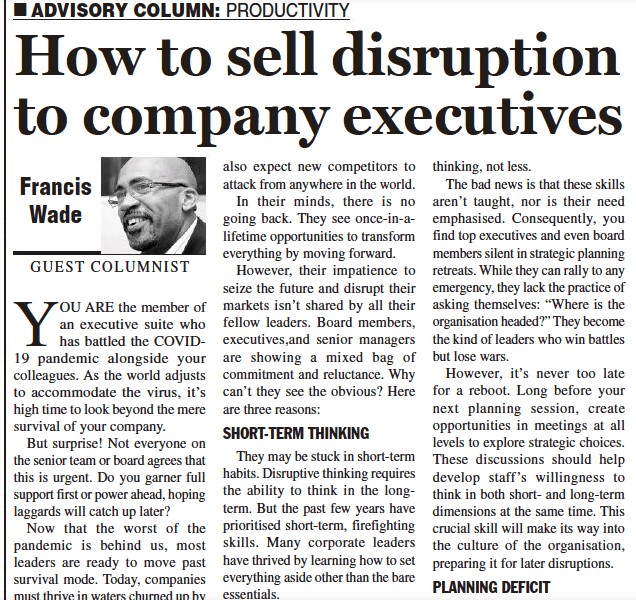You’re the member of an executive suite who has battled the COVID-19 pandemic alongside your colleagues. As the world adjusts to accommodate the virus, it’s high time to look beyond the mere survival of your company. But…surprise! Not everyone on the senior team or board agrees this is urgent. Do you garner full support first or power ahead, hoping laggards will catch up later?
Now that the worst of the pandemic is behind us, most leaders are ready to move past survival mode. Today, companies must thrive in waters churned up by COVID-19, inflationary recession, armed conflict and unsteady supply chains.
However, a few visionary managers have outgrown a yearning for the old normal. Some are convinced that customer behavior has changed…permanently. They also expect new competitors to attack from anywhere in the world.
In their minds, there is no going back. They see once-in-a-lifetime opportunities to transform everything by moving forward.
However, their impatience to seize the future and disrupt their markets isn’t shared by all their fellow leaders. Board members, executives and senior managers are showing a mixed bag of commitment and reluctance. Why can’t they see the obvious?
- They are stuck in short-term habits
Disruptive thinking requires an ability to think in the long-term. But the past few years have prioritized short term, firefighting skills. Many corporate leaders have thrived by learning how to set everything aside, other than the bare essentials. In this emergency mode, they have adapted by becoming hyper-alert, flexible and willing to exert a great deal of energy at a moment’s notice.
But it’s not enough. In fact, their transition up the organizational ladder requires more strategic thinking, not less.
The bad news is that these skills aren’t taught, nor is their need emphasized. Consequently, you find top executives and even board members silent in strategic planning retreats. While they can rally to any emergency, they lack the practice of asking themselves: “Where is the organization headed?” They become the kind of leaders who win battles, but lose wars.
However, it’s never too late for a reboot. Long before your next planning session, create opportunities in meetings at all levels to explore strategic choices. These discussions should help develop staff’s willingness to think in both short- and long-term dimensions at the same time. This crucial skill will make its way into the culture of the organization, preparing it for later disruptions.
- They lack the skill of precise long-term planning
Newly promoted executives discover that an enthusiasm to be strategic is just the beginning. For example, in the middle of a retreat, when they are asked to create a detailed 20 and 30 year plan, they balk: “I can only think five years out.” Or, “Things are changing too quickly to look that far ahead.”
Too many leaders assume that because they can’t see how long-term planning works, it must not be possible.
When shown multiple examples of successful cases, their resistance softens, but the point is not to change their minds. It’s much more important to give them the necessary skill of long-term planning.
Unfortunately, even the best business schools only hint at this capability. If you’re an MBA, you may recall courses on strategic planning. But the case method of discussion which most use isn’t intended to teach you actual steps. That comes from real-life, and some lucky exposure.
However, the process is easy enough to follow, even for skeptical team members. In prior columns, I have laid out the steps in detail. Observe them, and you will have a skill which can be yours forever.
Don’t ignore the need to develop this competence among your leaders.
- They won’t collaborate
If you’re a top executive, you probably hate the occasions when you have to force people to act. At most, you receive grudging compliance. But you don’t get true understanding or intrinsic motivation, i.e. buy-in. Therefore, you feel forced to micro-manage.
Nevertheless, you won’t produce a disruptive strategy following this method. Why? A lasting, game-changing plan is beyond the brilliance of a single individual. Instead, it takes a multi-disciplinary team to envision the breakthrough and implement it together.
While a collaborative approach requires more time and interpersonal skills, it’s the only one which is sustainable. Selling a disruption to teammates calls for extraordinary capabilities, but these aren’t ordinary times. The remaining months of 2023 are a chance to separate your company from the Blackberrys in your industry…the failures. Make the most of it by including your colleagues from the very beginning in a smart way.
Francis Wade is the host of the Caribbean Strategy Conference on June 23-25. To search his prior columns on productivity, strategy, engagement and business processes, send email to columns@fwconsulting.com.

